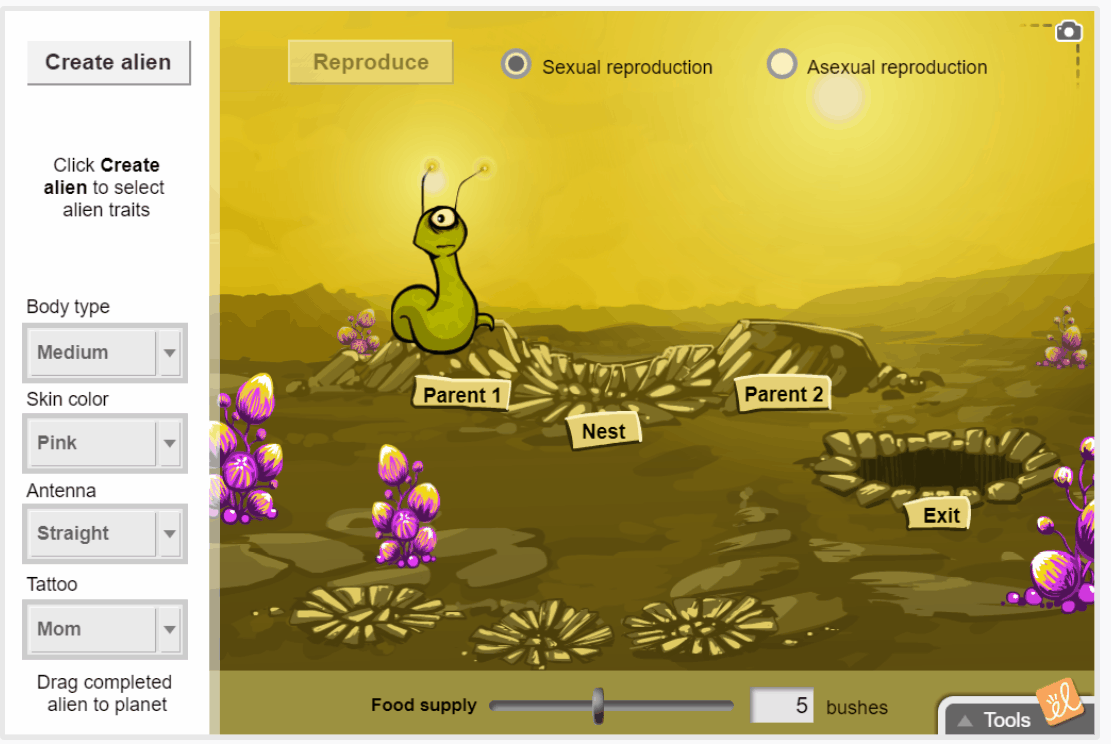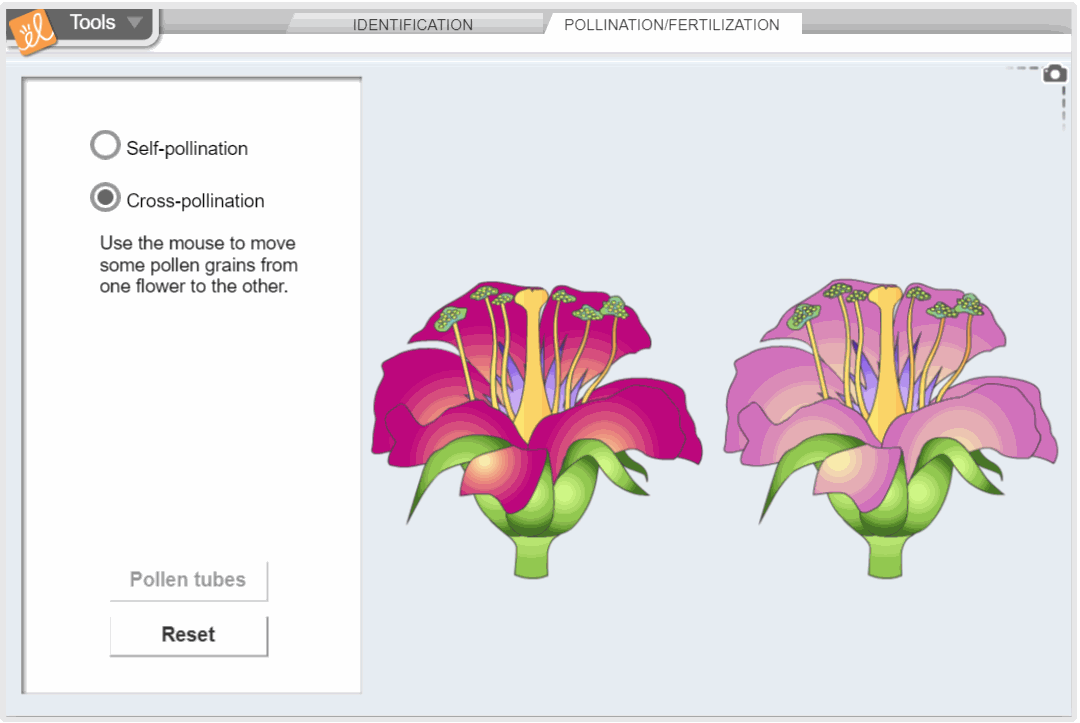
Like every other subject, effective biology teaching ideas use a variety of teaching strategies. When designing lesson plans, biology teachers look for activities that promote student engagement and motivation. Gizmos and STEM Cases make inquiry-based learning through biology simulations possible for all students.
Try Gizmos free for 45 days!
For a limited time, get an extended 45-day trial of Gizmos. Use code 45GIZIN to unlock your access. Transform your classroom and unlock students’ STEM potential today!
Why is biology important?
Biology is interesting because it explains the natural world. Students explore how living organisms function, interact, and adapt to the environment through biology activities. Using virtual labs combines the technology students love with biology lessons.
Gizmos simulations use an inquiry-based approach to learning validated by extensive educational research as a highly effective way to build conceptual understanding in math and science. Powerful interactive activities provide opportunities to visualize data, manipulate variables, and experiment while building students' skills to succeed in STEM.
Connecting the dots: How does biology relate to everyday life?
A teacher teaching biology has many options to relate it to students' everyday lives. Because biology studies life and its processes, just look around for lesson plan ideas! Biology relates to daily life, so it allows students to get creative and find some examples to share. Medications, agriculture, animals, foods, and beverages are a few places to start! Take that further by asking students to dive into inquiry, investigation, and CER (Claim, Evidence, and Reasoning).
Perform captivating biology experiments
Biology experiments pique students' curiosity. Learning is more interactive and interesting whenever students can see and do rather than listen to a lecture or read in a textbook. Teaching strategies in science can’t always involve physical labs, though.
ExploreLearning Learning Designer Carrie Adler noted that lab safety with larger class sizes can be a challenge. “Having processes in place to improve safety helps, such as good provisioning of supplies, minimizing student travel around the room, inviting administrators in for an extra set of hands,” she said.
Virtual simulations, like Gizmos, are effective alternatives to physical labs. “More and more, teachers need virtual alternatives to dissections due to limited resources, time constraints, health risks like pregnancy, or ethical concerns with animals as research subjects,” said Adler.
Biology lab experiments to spark student interest
Engage students with exciting projects that require involvement. Make it real by relating biology to everyday life. Encourage participation through surveys and polls with students. Use technology and interactive visuals.
Utilize project-based learning
Project-based learning allows students to investigate science concepts with real-world implications. With project-based learning, students are expected to be active and engaged in the learning process. Working together, they collaborate and explore authentic and fun biology activities. Virtual simulations, like the Inheritance Gizmo, make project-based learning activities interesting, interactive, and accessible.

8 engaging and innovative strategies for teaching biology
When teaching science, creative biology lesson plans make fun biology activities. There are a few things to keep in mind when planning successful biology lessons. Learning Designers Lauren Schetne, Ph.D., Suzanne Kehret, and Adler offered eight teaching strategies to try.
- Graphic Organizers:Photosynthesis and cellular respiration are always tricky subjects. Simplifying complex topics with visual aids that show the interconnection between these processes can greatly aid student understanding. Our new Gizmos Lessons offer opportunities for Beta Testing with teachers interested in these topics and others.
- Hands-On and Virtual Labs: While hands-on labs effectively teach the scientific method, online simulations provide a very efficient and powerful alternative.
- Virtual Dissections: These are excellent for students with safety concerns or ethical considerations and address resource limitations.
- Lab Safety: There is no substitute for laboratory safety. With larger class sizes, ensuring proper supply provisioning and minimizing student movement around the room is crucial. Having additional support can enhance safety.
- English Language Learners (ELLs) Supports: Word walls, images with text, and sentence frames are beneficial for ELL students - also known as Multilingual Learners (MLLs) - and all students by providing clear and accessible information.
- Collaborative Learning: According to Kehret, group projects and collaborative learning help students develop critical thinking and communication skills. “A lot of people forget that you can use Biology Gizmos for group activities like creating models or conducting experiments, and you get WAY more out of it when you have the kids discuss the simulation,” she said.
- Visualization Tools: Schetne recommended visual, interactive resources to make learning more engaging and comprehensible. She said, “For teaching organ and body systems, these tend to be resources that are really helpful in the classroom.”
- Careers exploration: Brainstorm careers that use concepts from biology, then ask students to research one that interests them. Host a virtual career day for further exploration with experts in different STEM and STEAM fields.
Ready to elevate your science lessons?
Gizmos Investigations are now available! These interactive, scaffolded science lessons combine Gizmo simulations with built-in student questioning and just-in-time feedback to support sensemaking practices. Designed to meet next-generation science standards, they help all students actively engage in the doing of science. Explore how Gizmos Investigations can transform your classroom today!
Enhance learning with inquiry-based methods and virtual labs
If you’re hoping to take away the stresses of physical biology lab experiments, virtual labs are the simple solution. Observe the steps of pollination and fertilization in flowering plants? Easy! Zoom in on cells to view the tiniest details? No problem. Avoid the issues that come with in-class frog dissections? You got it. Simulations, like Gizmos, also allow students to retry experiments as needed for better understanding.


Browse our collection of biology simulations. And bring engaging and effective instruction with over 550 Gizmos and STEM Cases in our library to your science classes with a free trial.
Article Contributors:
Carrie Adler is a learning designer and National Board-Certified Teacher of early adolescence/science education. She earned her B.S. in biology from Haverford College and her M.Ed. from the University of Maryland, College Park. She taught middle school science for 17 years in Montgomery County, Maryland, before joining ExploreLearning to design Gizmos STEM Cases.
Lauren Schetne is a learning designer and biologist. She earned her B.S. in Biological Sciences from the University of California, Santa Barbara and her Ph.D. in Developmental Cell Biology from the University of Denver. Prior to joining ExploreLearning, Lauren taught 7th grade science and college biology courses. Being able to share her love of learning and science is one of her favorite parts about creating Gizmos STEM Cases!
Suzanne Kehret is a learning designer with 18 years of experience in K-12 science education. She has a B.S. in Biology Education from Iowa State University and an M.A. in Educational Technology from Concordia University, St. Paul. Suzanne has worked as a science teacher, instructional technology coach, and curriculum coordinator, creating personalized, hands-on learning experiences. Now, as a Learning Experience Designer at ExploreLearning, she creates engaging, interactive lessons using eLearning tools to inspire students to explore and understand science in fun, meaningful ways.